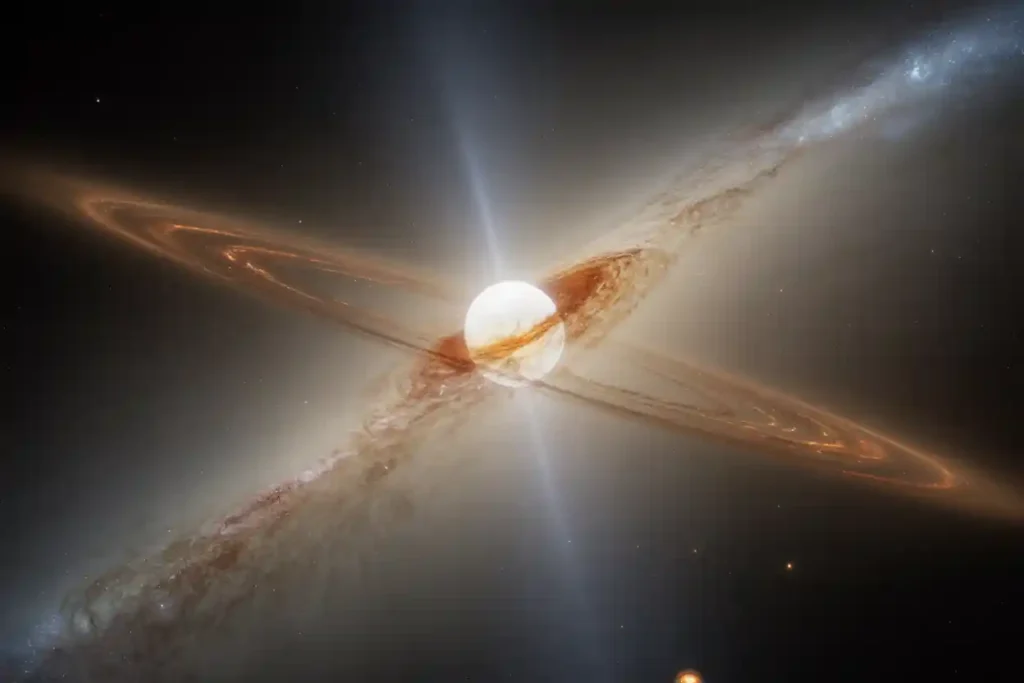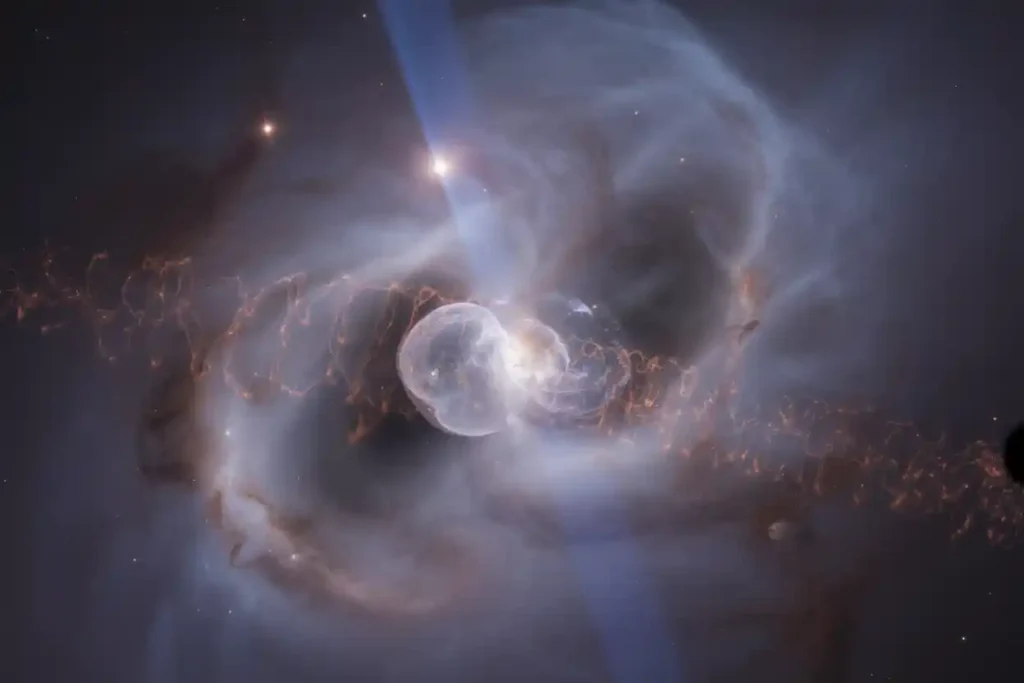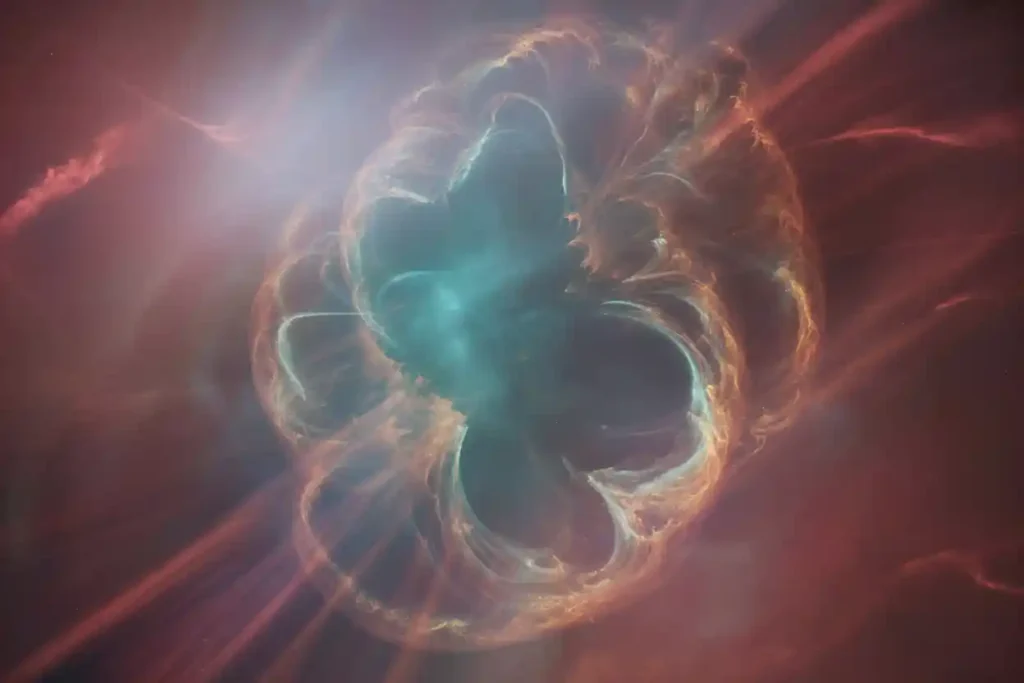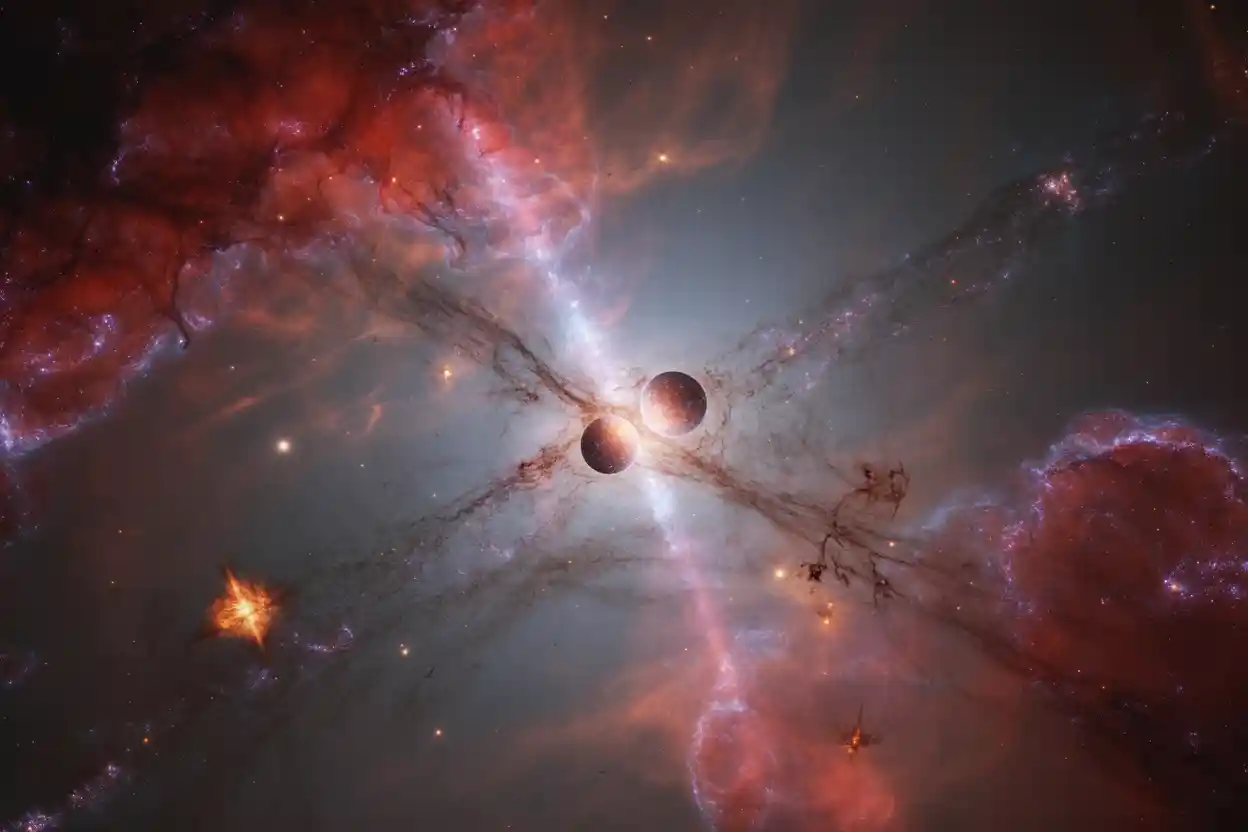For decades, astronomers have used the Hubble Space Telescope to peel back the layers of the universe, but every so often, a discovery changes the way we think about stars entirely.
The latest breakthrough comes with WD 0525+526, a star that looked perfectly ordinary at first glance. Located about 128 light-years away, this compact stellar remnant seemed no different from other white dwarfs—until scientists dug deeper with Hubble’s ultraviolet vision.
What they found was extraordinary: faint traces of carbon in its atmosphere, a chemical fingerprint that pointed to a violent past. Instead of being the quiet leftover of a single star, WD 0525+526 turned out to be the product of two stars colliding and merging into one.
In other words, Hubble Discovers White Dwarf Merger that challenges our understanding of star deaths, opening an entirely new window into how stellar remnants evolve.
What Are White Dwarfs? The Basics You Need to Know

To understand why the recent finding matters, it helps to first know what a white dwarf is. In simple terms, a white dwarf is the dense, burnt-out core of a star that has reached the end of its life.
When a star similar in size to our Sun runs out of nuclear fuel, it sheds its outer layers into space, often forming a colorful planetary nebula, while the remaining core collapses inward under gravity. What’s left behind is a white dwarf—an object roughly the size of Earth, but with a mass close to that of the Sun.
The numbers are staggering: a teaspoon of white dwarf material would weigh about 5 tons on Earth. These stellar remnants don’t produce new energy through fusion anymore; instead, they slowly cool and fade over billions of years.
Most white dwarfs have a fairly standard makeup. At their heart lies a core rich in carbon and oxygen, the byproducts of earlier fusion processes inside the original star.
Surrounding this core is a thin “atmosphere” or envelope, usually made of hydrogen or sometimes helium. In fact, astronomers classify white dwarfs by which element dominates their surface—hydrogen-dominated ones are called DA white dwarfs, while helium-dominated are DB white dwarfs.
This is why WD 0525+526 was so intriguing. On the surface, it seemed to fit neatly into this typical pattern. But, as the story unfolds, we’ll see why Hubble’s ultraviolet view exposed a very different history—laying the foundation for the headline: Hubble Discovers White Dwarf Merger that defies expectations.
Also Read: SpaceX Deploys 24 Starlink Satellites to Strengthen Global Internet Coverage
Hubble Discovers White Dwarf Merger Candidate WD 0525+526

At first glance, WD 0525+526 didn’t seem special. Sitting quietly about 128 light-years from Earth, it looked like just another white dwarf among the estimated 10 billion such stars in our galaxy. In visible light, it appeared unremarkable—no unusual glow, no strange brightness patterns, nothing to suggest a dramatic past.
But beneath that ordinary appearance was something extraordinary. Astronomers measured its mass at about 1.2 times that of the Sun, crammed into a body no bigger than Earth.
To put that into perspective, this tiny star packs the weight of our Sun into a sphere only about 12,000 kilometers across—a cosmic paradox of size and density.
Normally, white dwarfs with such high masses are rare, and many are thought to be the result of two stars merging. Yet, without more evidence, WD 0525+526 might have been overlooked as just another dense stellar core.
It took Hubble’s ultraviolet vision to reveal the truth. And that’s where the story truly takes a turn—Hubble Discovers White Dwarf Merger not through what was visible, but through what was hidden in its spectral fingerprints.
Ultraviolet Clues: How Hubble Revealed the Carbon Signature

The real breakthrough came when astronomers turned to Hubble’s Cosmic Origins Spectrograph (COS)—an instrument designed to analyze the universe in ultraviolet (UV) light. Unlike visible light, which shows us a star’s brightness and color, ultraviolet light exposes subtle chemical fingerprints hidden in a star’s atmosphere.
When COS studied WD 0525+526, it detected something unexpected: faint traces of carbon in the star’s outer layers. This was surprising because white dwarfs usually have surfaces dominated by hydrogen or helium. The presence of carbon suggested that deeper material from the star’s core had somehow made its way to the surface.
Here’s why Hubble was essential. The unusual carbon signature in WD 0525+526 was so faint that no ground-based telescope could have seen it. Earth’s atmosphere blocks most UV light, making it impossible to detect such weak signals from the ground.
Hubble, orbiting high above our planet, was able to capture these delicate spectral lines, revealing a hidden story that visible light alone could never tell.
This ultraviolet evidence provided the first big clue: what looked like an ordinary white dwarf was actually the remnant of a stellar collision. In other words, Hubble Discovers White Dwarf Merger not by how the star looked, but by what its invisible UV fingerprint revealed.
Hubble Discovers White Dwarf Merger Remnant: Evidence of a Stellar Collision
The ultraviolet fingerprints collected by Hubble left little doubt—WD 0525+526 wasn’t just any white dwarf, it was the survivor of a stellar collision. When two smaller white dwarfs spiral together and merge, they often produce a heavier, hotter remnant.
This is exactly what astronomers found here, making WD 0525+526 one of the clearest cases where Hubble Discovers White Dwarf Merger evidence in action.
One of the strongest signs of its unusual past is its atmosphere. WD 0525+526 has exceptionally thin hydrogen and helium layers, far thinner than those seen in typical white dwarfs. In fact, measurements suggest that hydrogen makes up just about 10⁻¹³.⁸ of its total mass, while helium accounts for around 10⁻¹².⁶.
These values are orders of magnitude lower than expected, pointing to the violent stripping of its outer layers during the merger.
Even more striking is its record-low carbon abundance. Normally, merger remnants tend to have stronger traces of carbon at their surface, since the mixing of stellar material dredges up elements from the core.
But WD 0525+526 showed a carbon-to-hydrogen ratio of log(C/H) = –4.62, making it 4 to 5 orders of magnitude lower than other known merger remnants. In other words, its carbon is so faint it nearly vanished, making it the first of its kind detected with such an unusual chemical profile.
This combination of extreme density, stripped outer layers, and faint carbon sealed its identity. What seemed ordinary in visible light turned out to be extraordinary under ultraviolet scrutiny. Once again, Hubble Discovers White Dwarf Merger proof that reshapes how astronomers recognize these cosmic survivors.
The Carbon Mystery: Semi-Convection Explained
The puzzle of WD 0525+526 didn’t end with its classification as a merger remnant. Astronomers were left wondering: how did carbon from deep inside the star reach the surface at all? Normally, white dwarfs this hot (over 30,000 Kelvin) don’t allow strong convection—the churning process that mixes materials inside stars.
At such high temperatures, the outer layers are stable, meaning carbon should remain locked away in the core, never showing up in the atmosphere.
Yet, Hubble’s ultraviolet data showed faint but undeniable carbon lines. Standard convection couldn’t explain it. This is where researchers introduced a new idea: semi-convection. Unlike full convection, which is vigorous and turbulent, semi-convection is a much more delicate process. It happens when small instabilities in the star’s structure allow tiny amounts of material to leak upward, layer by layer. In WD 0525+526, this subtle mechanism could slowly bring carbon atoms from the core into the surface atmosphere, explaining their ghostly presence.
For scientists, this discovery is groundbreaking. It shows that stellar mixing isn’t just “on” or “off”—it can exist in subtle shades in between. Semi-convection may be far more important in white dwarfs than previously thought, especially in those created through mergers.
By revealing this hidden process, Hubble Discovers White Dwarf Merger not only uncovered the star’s past but also provided new insights into the complex physics that govern how stars age and evolve.
Why Hubble Discovers White Dwarf Merger Is a Big Deal
The discovery of WD 0525+526 goes far beyond a single star—it has major implications for our understanding of the life cycles of binary stars. Many stars in our galaxy exist in pairs, and over billions of years, some of these pairs merge.
Until now, astronomers had difficulty identifying the remnants of such collisions, especially when the resulting white dwarfs appeared ordinary in visible light. Hubble’s ultraviolet observations show that these hidden mergers may be far more common than previously thought.
One particularly exciting consequence relates to Type Ia supernovae. These are powerful stellar explosions used as cosmic distance markers, essential for measuring the expansion of the universe. Many Type Ia supernovae are believed to originate from merging white dwarfs.
By identifying a merger remnant like WD 0525+526, scientists gain a rare window into the pre-supernova conditions, helping refine models of how these cosmic events unfold.
Finally, this discovery forces astronomers to reconsider the so-called “quiet” white dwarf population. Some stars previously thought to be normal may, in fact, be hidden merger remnants—stars with violent pasts masked by unassuming appearances.
In other words, Hubble Discovers White Dwarf Merger not only reveals a single cosmic collision but also hints at a whole unseen population of similar stellar survivors, reshaping our view of stellar evolution in the galaxy.
The Future of Stellar Forensics with Hubble and Beyond
The discovery of WD 0525+526 marks just the beginning of a new era in stellar forensics. By using ultraviolet surveys, astronomers can now search for more hidden white dwarf mergers that may have gone unnoticed in visible light.
Expanding these surveys could reveal the true number of such merger remnants in our galaxy, providing crucial statistics for models of binary star evolution.
Hubble’s success also highlights the need for future UV-capable space telescopes. While Hubble continues to operate well beyond its expected lifespan, the next generation of UV observatories will allow scientists to study fainter and more distant white dwarfs, mapping chemical signatures in unprecedented detail.
This capability will be vital for uncovering subtle evidence of past stellar collisions, much like what we saw with WD 0525+526.
Beyond individual stars, this research has a broader impact on understanding stellar life cycles. By identifying merger remnants and studying their chemical composition, astronomers can refine models of how stars age, interact, and end their lives—whether as quiet white dwarfs or as progenitors of supernovae.
In this way, Hubble Discovers White Dwarf Merger not only solves a single stellar mystery but also opens the door to a richer, more complete picture of our galaxy’s dynamic past.
The discovery of WD 0525+526 has transformed our understanding of what appears to be an ordinary white dwarf. Through Hubble’s ultraviolet observations, astronomers uncovered faint carbon signatures that revealed a dramatic past—showing that this star is the remnant of a stellar collision.
This finding demonstrates that some stars we previously thought were typical may actually be survivors of cosmic mergers, hiding violent histories beneath calm exteriors.
In other words, Hubble Discovers White Dwarf Merger and reveals that many stars may hide violent pasts, offering new insights into binary star evolution, the origins of Type Ia supernovae, and the broader population of white dwarf merger remnants.
Even decades after its launch, Hubble continues to uncover cosmic secrets, proving that the universe still has countless hidden stories waiting to be told. This discovery not only adds a remarkable chapter to stellar evolution but also paves the way for future ultraviolet studies that may reveal even more hidden mergers across our galaxy.




